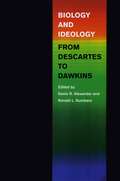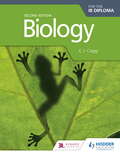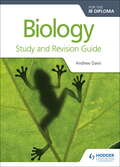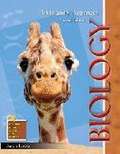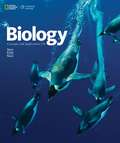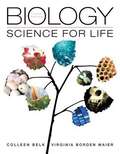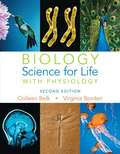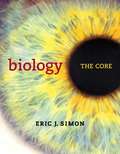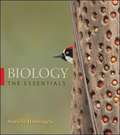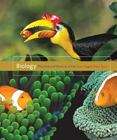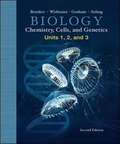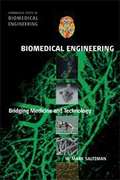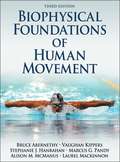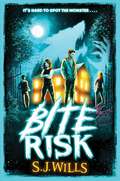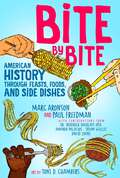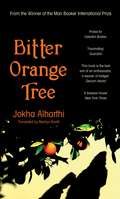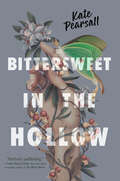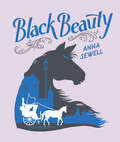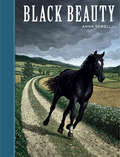- Table View
- List View
Biology and Ideology from Descartes to Dawkins
by Ronald L. Numbers Denis R. AlexanderUntil well into the twentieth century neither scientists themselves nor the scholars who studied science linked science with ideology, a term coined in the late eighteenth century and typically employed pejoratively to designate ideas in the use of particular interests. Among the first to connect ideology and science were Karl Marx and his followers, who identified "ideologies" as ideas that served the social interests of the bourgeoisie.
Biology for the IB Diploma Second Edition
by Andrew Davis C. J. CleggProvide clear guidance to the 2014 changes and ensure in-depth study with accessible content, directly mapped to the new syllabus and approach to learning.This second edition of the highly regarded textbook contains all SL and HL content, which is clearly identified throughout. Options are available free online, along with appendices and data and statistics.- Improve exam performance, with exam-style questions, including from past papers- Integrate Theory of Knowledge into your lessons and provide opportunities for cross-curriculum study- Stretch more able students with extension activities- The shift to concept-based approach to learning , Nature of Science, is covered by providing a framework for the course with points for discussion - Key skills and experiments included
Biology for the IB Diploma Study and Revision Guide
by Andrew Davis C. J. CleggStretch your students to achieve their best grade with these year round course companions; providing clear and concise explanations of all syllabus requirements and topics, and practice questions to support and strengthen learning. - Consolidate revision and support learning with a range of exam practice questions and concise and accessible revision notes- Practise exam technique with tips and trusted guidance from examiners on how to tackle questions- Focus revision with key terms and definitions listed for each topic/sub topic
Biology for the IB MYP 4 & 5: By Concept
by Andrew Davis Patricia DeoEndorsed by the IBDrive meaningful inquiry through a unique concept-driven narrative.- Supports every aspect of assessment with opportunities that use the criteria- Gives you easy ways to differentiate and extend learning- Provides a meaningful approach by integrating the inquiry statement in a global context- Develops critical-thinking skills with activities and summative sections rooted in the ATL frameworkThis title is also available in two digital formats via Dynamic Learning. Find out more by clicking on the links at the top of the page.
Biology: Concepts And Applications
by Cecie Starr Lisa Starr Christine A. EversIn the new edition of BIOLOGY: CONCEPTS AND APPLICATIONS, authors Cecie Starr, Christine A. Evers, and Lisa Starr have partnered with the National Geographic Society to develop a text designed to engage and inspire. This trendsetting text introduces the key concepts of biology to non-biology majors using clear explanations and unparalleled visuals. While mastering core concepts, each chapter challenges students to question what they read and apply the concepts learned, providing students with the critical thinking skills and science knowledge they need in life. Renowned for its writing style the new edition is enhanced with exclusive content from the National Geographic Society, including over 200 new photos and illustrations. New People Matter sections in most chapters profile National Geographic Explorers and Grantees who are making significant contributions in their field, showing students how concepts in the chapter are being applied in biological research. Each chapter concludes with an 'Application' section highlighting real-world uses of biology and helping students make connections to chapter content.
Biology: Concepts and Investigations 3rd Edition
by Mariëlle HoefnagelsMariëlle Hoefnagels' passion as a classroom instructor is evident in Biology: Concepts and Investigations, an introductory biology textbook written to explain the general concepts of biology at a level of detail that allows students to understand concepts rather than memorise details. New media integration icons, upgraded PowerPoint presentations, new tutorial animations based on textbook art, upgraded Connect question banks, and adaptive technologies like LearnSmart and Smartbook capitalise on the power of technology to enhance student understanding. Key goals of the book are to: help the student connect the concepts in the book to their everyday lives; show connections between ideas within the chapter and to material they have already studied; teach introductory students how to be more active learners.
Biology: Science for Life
by Colleen Belk Virginia Borden MaierColleen Belk and Virginia Borden Maier have helped students understand biology for more than twenty years in the classroom and over ten years with their popular text, Biology: Science for Life. The thoroughly revised Fifth Edition engages students with new storylines that explore high-interest topics such as binge drinking, pseudoscience, and study drugs.
Biology: Science for Life with Physiology
by Colleen Belk Virginia BordenThe author's experiences of the sciences life such as: Cells, metabolism, and life in the genetics.
Biology: Student Study Guide (Ninth Edition)
by Sylvia S. MaderThe Study Guide is designed to accompany your text, Biology, ninth edition, by Sylvia S. Mader. A number of different approaches are used to help you achieve mastery of the chapter concepts.
Biology: The Core
by Eric J. SimonEric Simon’s Biology: The Core combines a 12-chapter textbook and robust content in Mastering Biology to offer a flexible new teaching and learning package that engages you with concise writing, beautiful and effective visuals, and outstanding interactive digital resources.
Biology: The Essentials
by Mariëlle HoefnagelsHOEFNAGELS: BIOLOGY: THE ESSENTIALS Mariëlle Hoefnagels presents up-to-date information using a scientific approach and relevant examples to illustrate the basic biological concepts. Mariëlle's focus on evolutionary processes and implications aid a cross-disciplinary approach to the study of Biology, which will help students make connections and grasp the importance and relevance of biology in their lives. BIOLOGY EXPLAINED YOUR WAY - In writing this book Mariëlle has maintained a TOTAL FOCUS ON THE STUDENT and what they need to be successful in this course by providing the tools and direction needed to support understanding and learning, not memorizing. Her primary goal has been to simplify the more complicated biological content to the elements that students need to actually understand it. WANT TO DELIVER AN ESSENTIAL OVERVIEW? The early sections of the chapters serve as an overview that introduces the importance and overall result of the process but skips the detail.
Biology: The Unity and Diversity of Life
by Cecie Starr Lisa Starr Ralph Taggart Christine EversWritten by a team of best-selling authors, BIOLOGY: THE UNITY AND DIVERSITY OF LIFE, 14th Edition reveals the biological world in wondrous detail. This text shows and tells the fascinating story of life on Earth, and engages readers with hands-on activities that encourage critical thinking. Chapter opening Learning Roadmaps help students focus on the topics that matter most and section-ending "Take Home Messages" reinforce key concepts. Helpful in-text features include a running glossary, case studies, issue-related essays, linked concepts, self-test questions, data analysis problems, and more. BIOLOGY: THE UNITY AND DIVERSITY OF LIFE, 14th Edition puts the living world of biology under a microscope for readers from all walks of life to analyze, understand, and enjoy!
Biology: The Unity and Diversity of Life (12th edition)
by Cecie Starr Lisa Starr Ralph Taggart Christine EversThe 12th edition of this undergraduate text seeks to make students aware of the connection between molecular change, evolution, and students' own lives. To achieve this goal, the text features essays on current controversial issues, links to concepts within and between chapters, two-page concept spreads, and problem solving examples and experiments that encourage students to think critically. Other changes include reorganized and rewritten material on areas such as energy flow and stem cell research. Author information is not given.
Biology: Units 1,2, and 3
by Eric P. Widmaier Robert J. Brooker Linda Graham Peter StilingThis Volume of Biology covers Chemistry, Cell Biology, and Genetics. The Brooker et. al text features an evolutionary focus with an emphasis on scientific inquiry.
Biomedical Engineering for Global Health
by Rebecca Richards-KortumCan technology and innovation transform world health? Connecting undergraduate students with global problems, Rebecca Richard-Kortum examines the interplay between biomedical technology design and the medical, regulatory, economic, social and ethical issues surrounding global health. Driven by case studies, including cancer screening, imaging technologies, implantable devices and vaccines, students learn how the complexities and variation across the globe affect the design of devices and therapies. A wealth of learning features, including classroom activities, project assignments, homework problems and weblinks within the book and online, provide a full teaching package. For visionary general science and biomedical engineering courses, this book will inspire students to engage in solving global issues that face us all.
Biomedical Engineering: Bridging Medicine and Technology
by W. Mark SaltzmanThis book is an introduction to biomedical engineering, starting from the basics and demonstrating the engineering principles that are used to create new diagnostic methods and therapies for human disease. Although biomedical engineering is a relatively new field of study, it will impact almost every person in the world.
Biophysical Foundations of Human Movement (3rd Edition)
by Bruce Abernethy Vaughan Kippers Stephanie Hanrahan Marcus Pandy Ali Mcmanus Laurel Mackinnon"Biophysical Foundations of Human Movement, Third Edition," introduces readers to key concepts concerning the anatomical, mechanical, physiological, neural, and psychological bases of human movement. The text provides undergraduate students with a broad foundation for more detailed study of the subdisciplines of human movement and for cross-disciplinary studies. Readers will learn the multi-dimensional changes in movement and movement potential that occur throughout the life span as well as those changes that occur as adaptations to training, practice, and other lifestyle factors. This third edition includes the latest research and improved presentation to address areas of growth and change in the fields of human movement. The following are important updates to this edition: - A new chapter on historical origins of human movement science provides students with an appreciation of the development of the field as well as its future directions. - Content regarding exercise physiology has been reorganized to provide more discrete coverage of key concepts in nutrition. - A new concluding section focuses on applications in the areas of prevention and management of chronic disease, prevention and management of injury, and performance enhancement in sport and the workplace, as well as the benefits of sport and exercise science to work, sport, and everyday living. - Ancillary materials support instructors in teaching across disciplines as they assist students in understanding the breadth of content in this comprehensive text. Using a modular approach to teaching sport and exercise science, "Biophysical Foundations of Human Movement, Third Edition," offers students a structured understanding of how the subdisciplines work independently and in tandem. Following a general introduction to the field of human movement studies, readers are introduced to basic concepts, life-span changes, and adaptations arising in response to training in each of the five major biophysical subdisciplines of human movement. Each subdiscipline is given a brief introduction, including the definition and historical development of the subdiscipline, the typical issues and problems it addresses, the levels of analysis it uses, and relevant professional training and organizations. Multi-disciplinary and cross-disciplinary approaches to human movement are also discussed along with contemporary applications. By studying the integration of knowledge from a number of the biophysical subdisciplines, students will be better prepared for advanced study and careers reliant on the integration of knowledge from various disciplines and perspectives. The third edition offers tools for retaining the material, including learning objectives and summaries in each chapter, a glossary, and lists of web-based resources. Throughout the text, special "In Focus" features highlight key organizations, individuals, and studies from around the world that have contributed to the current understanding of human movement. These features help readers appreciate the evolution of the field so that they may better understand its direction. Students interested in further study will find specialized texts for each of the subdisciplines listed in the Further Reading and References section of each chapter along with updated lists of websites. The third edition of "Biophysical Foundations of Human Movement" offers a comprehensive introduction for students, scientists, and practitioners involved in the many professions grounded in or related to human movement, kinesiology, and sport and exercise science. By considering the effect of adaptations in each of the biophysical subdisciplines of human movement, "Biophysical Foundations of Human Movement" also illustrates the important role physical activity plays in the maintenance of health throughout the life span.
Bird of a Thousand Stories (Once There Was)
by Kiyash MonsefIn this transporting and suspenseful companion to the New York Times bestselling Once There Was that&’s perfect for fans of Impossible Creatures, Marjan travels around the globe in search of a mythical bird in terrible danger, whose fate could determine the future of the world. Marjan Dastani is successfully leading a double life. Only a few people know that when she&’s not in school, she travels the world taking care of mythical beasts, sent on missions by a shadowy organization known as The Fells. In an adventure that takes her across continents and connects her with the wildest of mythic beasts around the globe, Marjan must track down the fabled Bird of a Thousand Stories before someone with more nefarious plans finds it. But the more closely she connects with the world&’s mythical creatures, the more danger she&’s in of losing her friendships—and all that tethers her to the life she&’s known.
Bite Risk (Bite Risk)
by S.J. WillsThe Last Kids on Earth gets a lupine twist by way of Margaret Peterson Haddix in this eerie middle grade adventure set in a small town where all the adults are werewolves but the kids begin to suspect something else sinister is putting them at even greater risk.When everyone&’s a werewolf, it&’s hard to spot the monster… Thirteen-year-old Sel lives in the remote, isolated town of Tremorglade, where nothing interesting ever seems to happen. Well, unless you count the one night a month when the full moon rises and kids like him must lock up their parents while they transform into werewolves (though Tremorgladers prefer to call them Rippers). But that&’s the whole world&’s new normal since the Disruption changed everything well before Sel was born. But when strange things begin happening in Tremorglade, like drones emitting sickening sounds and people behaving oddly, Sel and his friends begin asking questions about what&’s really going on in their small town. And suspiciously soon after they do, Rippers begin escaping on confinement nights, people start disappearing, and the kids suspect they&’re being followed. Maybe there&’s a reason no one ever seems to leave Tremorglade…and it&’s up to Sel and his friends to figure out the truth someone doesn&’t want them to know before another full moon puts them all at a bite risk.
Bite by Bite: American History through Feasts, Foods, and Side Dishes
by Marc Aronson Paul Freedman Frederick Douglass Opie Amanda Palacios Tatum Willis David ZhengExplore the fascinating history of America as told through the lens of food in this illustrated nonfiction middle grade book that lays out the diverse cultures that have combined to create the rich and delicious tapestry of the American country and cuisine.As American as apple pie. It&’s a familiar saying, yet gumbo and chop suey are also American! What we eat tells us who we are: where we&’re from, how we move from place to place, and how we express our cultures and living traditions. In twelve dishes that take readers from thousands of years ago through today, this book explores the diverse peoples and foodways that make up the United States. From First Salmon Feasts of the Umatilla and Cayuse tribes in the Pacific Northwest to fish fries celebrated by formerly enslaved African Americans, from &“red sauce&” Italian restaurants popular with young bohemians in the East to Cantonese restaurants enjoyed by rebellious young eaters in the West, this is the true story of the many Americas—laid out bite by bite.
Bitter Orange Tree
by Jokha AlharthiZuhur, an Omani student at a British university, is caught between the past and the present. As she attempts to form friendships and assimilate in Britain, she can&’t help but ruminate on the relationships that have been central to her life. Most prominent is her strong emotional bond with Bint Amir, a woman she always thought of as her grandmother, who passed away just after Zuhur left the Arabian Peninsula. As the historical narrative of Bint Amir&’s challenged circumstances unfurls in captivating fragments, so too does Zuhur&’s isolated and unfulfilled present, one narrative segueing into another as time slips, and dreams mingle with memories.The eagerly awaited new novel by the winner of the Man Booker International Prize, Bitter Orange Tree is a profound exploration of social status, wealth, desire, and female agency. It presents a mosaic portrait of one young woman&’s attempt to understand the roots she has grown from, and to envisage an adulthood in which her own power and happiness might find the freedom necessary to bear fruit and flourish.
Bittersweet in the Hollow (Bittersweet In The Hollow (trade) Ser.)
by Kate PearsallIn this beautifully dark and enthralling YA, four sisters with unusual talents investigate a mysterious disappearance in their secluded Appalachian town. For fans of House of Hollow and Wilder Girls!In rural Caball Hollow, surrounded by the vast National Forest, the James women serve up more than fried green tomatoes at the Harvest Moon diner, where the family recipes are not the only secrets.Like her sisters, Linden was born with an unusual ability. She can taste what others are feeling, but this so-called gift soured her relationship with the vexingly attractive Cole Spencer one fateful night a year ago . . . A night when Linden vanished into the depths of the Forest and returned with no memories of what happened, just a litany of questions—and a haze of nightmares that suggest there&’s more to her story than simply getting lost.Now, during the hottest summer on record, another girl in town is gone, and the similarities to last year&’s events are striking. Except, this time the missing girl doesn&’t make it home, and when her body is discovered, the scene unmistakably spells murder.As tempers boil over, Linden enlists the help of her sisters to find what&’s hiding in the forest . . . before it finds her. But as she starts digging for truth—about the Moth-Winged Man rumored to haunt the Hollow, about her bitter rift with Cole, and even about her family—she must question if some secrets are best left buried.
Black Beauty (Children's Signature Clothbound Editions)
by Anna SewellThis powerful narrative, told from the perspective of a horse, is now available in an unabridged, illustrated cloth hardcover edition in Union Square and Co.&’s Children's Signature Clothbound Classics series. Despite Black Beauty being her only published work, Anna Sewell is widely regarded as one of the most successful children's novelists from England. Black Beauty chronicles the life of a horse in Victorian England. At the hands of different owners, he experiences discipline, friendship, overwork, and, ultimately, love. Young readers will be moved by this empathetic novel about animal treatment—a story that&’s still relevant even today.
Black Beauty (Union Square Kids Unabridged Classics)
by Anna SewellThe illustrations for this series were created by Scott McKowen, who, with his wife Christina Poddubiuk, operates Punch & Judy Inc., a company specializing in design and illustration for theater and performing arts. Their projects often involve research into the visual aspects of historical settings and characters. Christina is a theater set and costume designer and contributed advice on the period clothing for the illustrations.Scott created these drawings in scratchboard an engraving medium which evokes the look of popular art from the period of these stories. Scratchboard is an illustration board with a specifically prepared surface of hard white chalk. A thin layer of black ink is rolled over the surface, and lines are drawn by hand with a sharp knife by scraping through the ink layer to expose the white surface underneath. The finished drawings are then scanned and the color is added digitally.Every child loves a story about a horse, and Black Beauty remains one of the finest, most touching ever written. Set in Victorian London, the novel follows the shifting fortunes of a horse as he moves from owner to owner. Narrated by the noble Black Beauty himself, the tale offers an animal’s perspective of the world, and highlights the thoughtless, even cruel treatment animals endured during that period.
